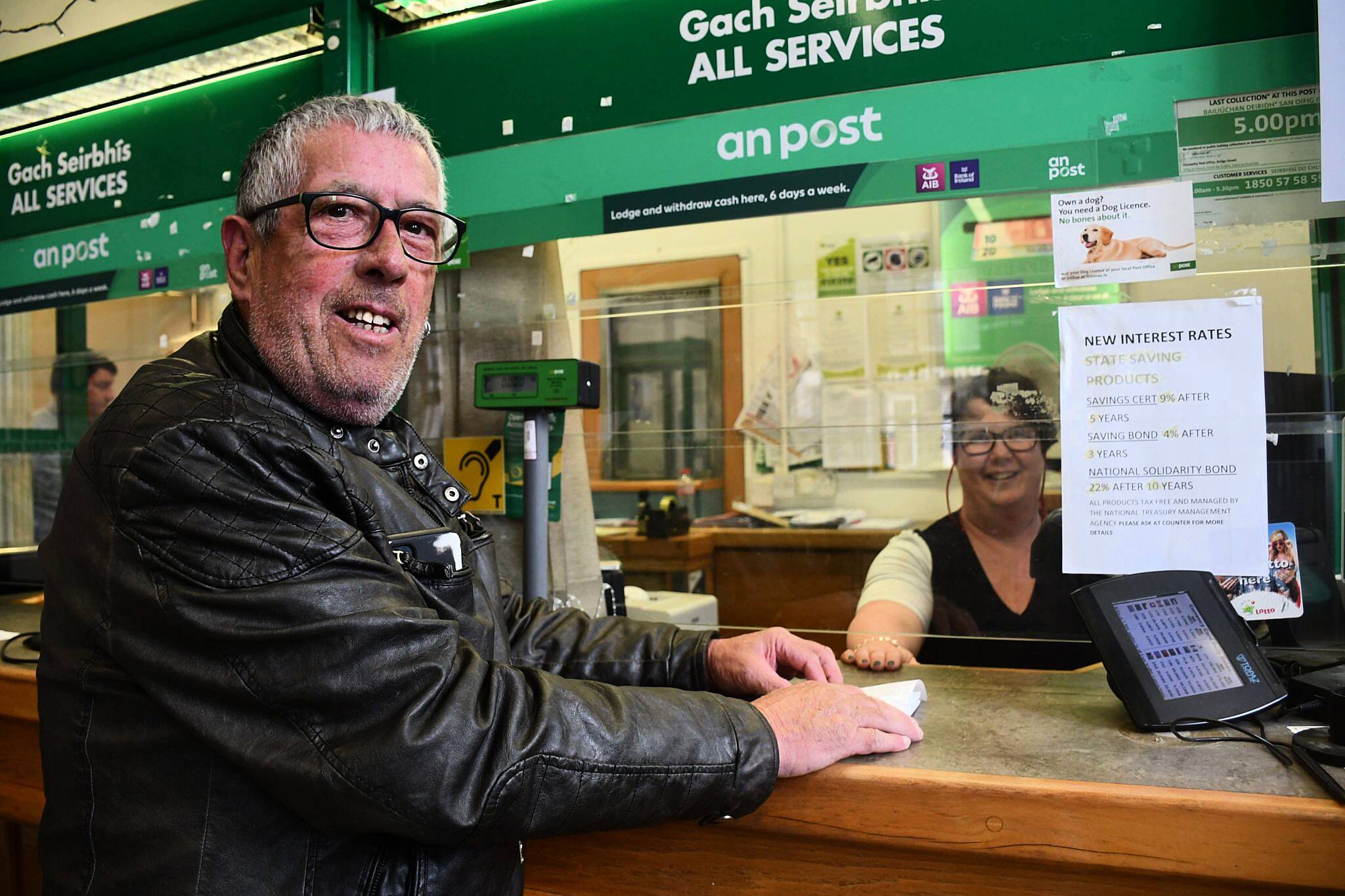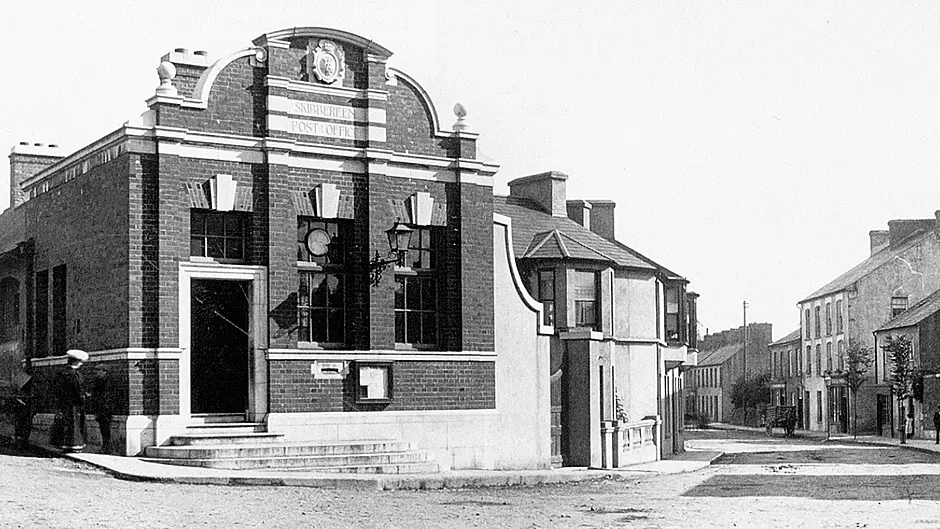Now moved to the nearby Drinagh Co-op grocery outlet, it’s a little-known fact that one of the town’s first ‘post offices’ was also in a grocer’s.
BY ROBERT HUME
A special place to send parcels, cards, registered letters and telegrams, buy stamps and postal orders, deposit savings, and receive weekly pension payments.
Post offices once provided facilities that could be found nowhere else.
Horse-drawn carts cluttered the roads, and a man carrying a long pole set streetlamps aglow each evening when Skibbereen’s present post office building opened in 1904.
There were no pensions for the elderly in need, only workhouses.
A silver watch might set you back a guinea, a yearly subscription to The Southern Star six shillings and sixpence.
Ireland was ruled by the British King, Edward VII, and pillar boxes were painted red.
The town’s post office had no fixed location, being situated wherever the postmaster happened to live.
The earliest record I’ve found of such a building comes from a letter in National Archives Ireland, mailed on April 18th 1798 from Skibbereen Post Office.
It was sent to John Lees, Secretary to the Post Office in Ireland, by Mathew Sweetnam, who commented on postal difficulties due to the ‘disturbed state of the country’.
In 1824, postmaster George Levis, who resided in Main Street, Skibbereen, was also a dyer and grocer.
Twice a day things got hectic: ‘The mail from Dublin and all parts of Great Britain arrives every afternoon at half-past four, and is despatched in the morning at eight’, records Pigott’s Directory.
The Skibbereen Eagle reported in 1892 that people were unhappy about ‘the inconvenient position’ of the premises that had been ‘doing duty’ as a post office.
But when the building caught fire in May that year, Edward Barry, MP for Cork South, complained that the accommodation which replaced it, with ‘narrow passages and steps’, was also ‘inadequate and insufficient’ for a ‘large and important commercial town’.
In 1894, the post office was located in The Square where, in more recent years Hickey’s newsagents stood (now part of Fields’ coffee shop).
Managed by the ‘energetic’ Mr C. O’Shea, the building was described by The Southern Star as ‘well-ventilated and well-lighted’.
But by 1900 larger premises, including a pub, were being suggested, so business could be transacted without ‘jostling or crushing’.
A possible site was discussed at the far end of North Street, another in Market Street, opposite the Bank of Ireland, and closer to the railway station.
Three years of wrangling followed, until January 1903, when ratepayers, greeted by a brass band, finally met and chose Market Street.
 Ken Brien and staff member Karen McDermott at the counter in the old Skibbereen Post Office on Friday, April 25th, the last day of service at that premises.
Ken Brien and staff member Karen McDermott at the counter in the old Skibbereen Post Office on Friday, April 25th, the last day of service at that premises.
Local labour would be employed to erect a gable-fronted, single-storey building of limestone with a red brick front and slate roof.
The contractor, Denis Creedon from Fermoy, had to complete the work by 31 December 1904, or risk being fined £5 per week.
Before his new quarters were ready, postmaster John Bournes had appeared in court in Skibbereen to testify against Ballydehob postman Cornelius Regan, who was charged with tearing up and throwing letters into the river while drunk on Christmas Eve 1903.
The building was up and running by September 1904.
Although boasting a splendid royal crest on the front, one councillor reckoned it resembled a ‘large shed’.
Either way, the new post office gave Skibbereen a vital communications hub.
It accepted parcels and letters, and sold postage stamps and postal orders.
Deposits could be made into a savings bank, and, from 1909, Old Age Pensions were paid to those over 70.
With no telephones in Skibbereen until 1926, it also provided a telegraph service.
 Mrs. Marie Connolly, Skibbereen leaving the Post Office on Friday morning.
Mrs. Marie Connolly, Skibbereen leaving the Post Office on Friday morning.
When popular postmaster Michael J. Somers retired in 1928, he was praised for maintaining a regular service during the troubled 1920s, when mail train robberies were rife.
Throughout his nine years in Skibbereen, he had tried to improve staff wellbeing and safety at work.
But in January 1938, John Young from Dunmanway, a telegram messenger at Skibbereen Post Office, was found lying unconscious by his bicycle along the roadside at Bunalun.
As the business grew, the building (only 264 sq. m) began to experience the same overcrowding as its predecessors: The Southern Star reported queues spilling into the street in 1988, and ‘chaotic’ and ‘cramped’ conditions in 1990.
The opening of a new delivery unit near the roundabout at the end of Market Street in 2019 eventually helped ease congestion.
 Staff members Karen McDermott, Trish O’Mahony, Caroline Collins, and David Jennings before closing the door on the historic post office for the last time. (Photos: Anne Minihane)
Staff members Karen McDermott, Trish O’Mahony, Caroline Collins, and David Jennings before closing the door on the historic post office for the last time. (Photos: Anne Minihane)
These days, every single transaction a post office provides can be made elsewhere.
People don’t write letters, they instead communicate by email and WhatsApp, while the elderly can have their pension paid directly into their bank accounts.
Nevertheless, mixed reactions have followed the closing down of Skibbereen Post Office last Friday, April 25th, and the moving of services into Drinagh’s Eurospar.
Maggie Jenkins remembers the days of the past well: ‘So sad. I have memories of walking up Townshend Street to the post office in around 1960, with my cousins, to cash the order an aunt had sent from America’.
However, Anna Courtney sees things differently: ‘As much as I love this building, it will be easier for me, and others too, to get a parking space at Drinagh’.
The move into a supermarket calls to mind how one of Skibbereen’s early post offices was also located in the premises of a grocer: we have gone full circle.
 Michael Collins speaking in the Square in Skibbereen in 1922. The post office is clearly visible in the background.
Michael Collins speaking in the Square in Skibbereen in 1922. The post office is clearly visible in the background.The end of an era
BY ANNE MINIHANE
Last Friday afternoon, Skibbereen Post Office relocated from the iconic red brick building in the centre of the town to its new home at the other end of Market Street at Drinagh Eurospar.
To mark the day, many people called in to pass on their best wishes to the staff members David, Caroline, Karen and Trish while The Southern Star was on hand to witness the end of an era.
Most people were sad to see the post office leave its old home, but many remarked that more parking facilities and easier access to the building are very important for the older people in the community, and the relief that Skibbereen is retaining its post office service was a point made by everyone who stopped to chat.
Local women Eleanor Uí Drisceoil and Maureen Courtney reminisced about the beautiful old building and how sad they’ll feel to see the door closed.
The building, they said, is part of the traditions in the town.
Meanwhile, Ken Brien from Skibbereen said that though it’s sad to leave the lovely building, he felt keeping the post office in the town was the most important thing.
Josephine Caverley from Dreeny was also sorry to see it leave its traditional home, but likewise glad to see that ‘we have a post office in the town’.
The doors were closed and locked for the last time on Friday evening by postmaster David Jennings, ready to reopen services in the nearby Drinagh Eurospar on Monday this week.








